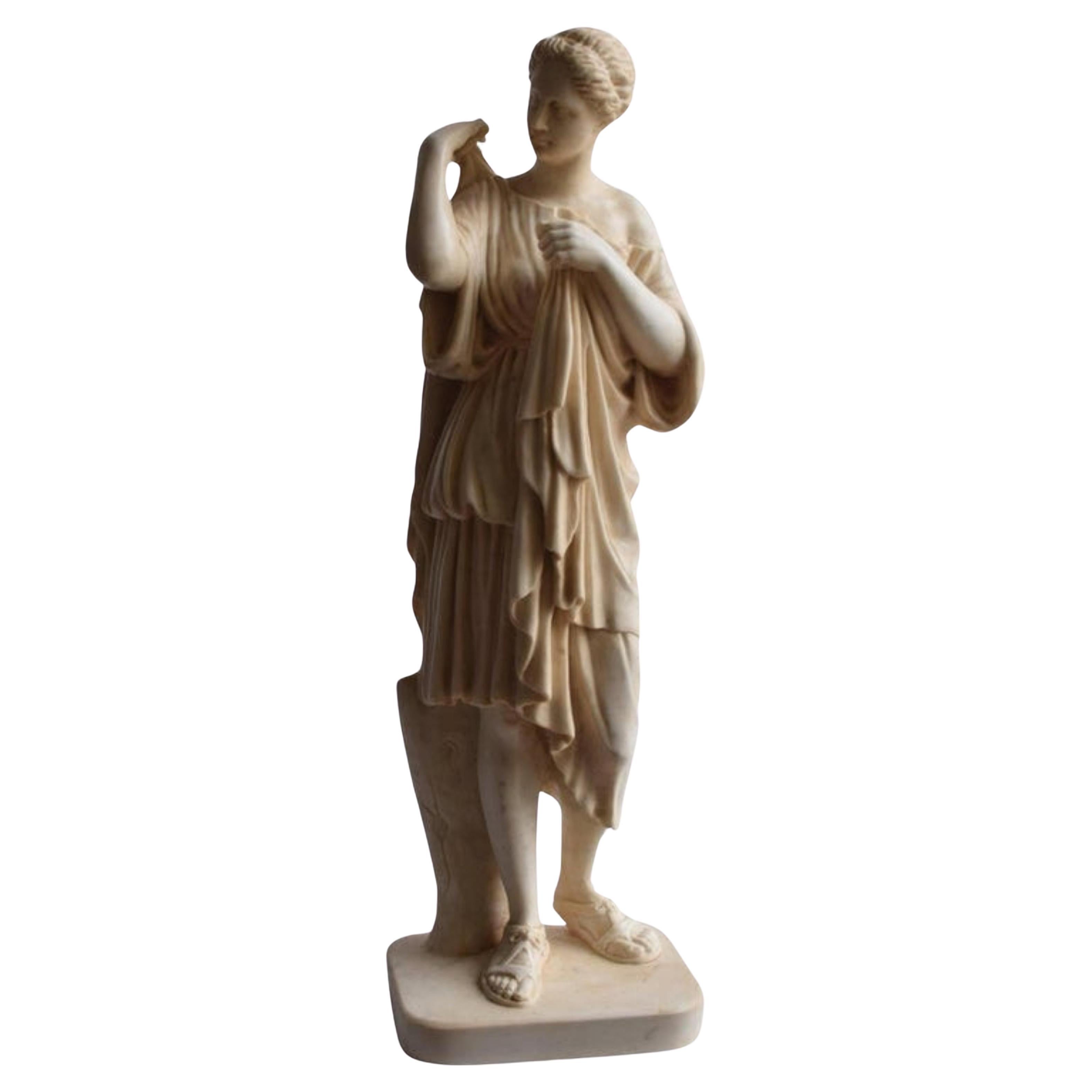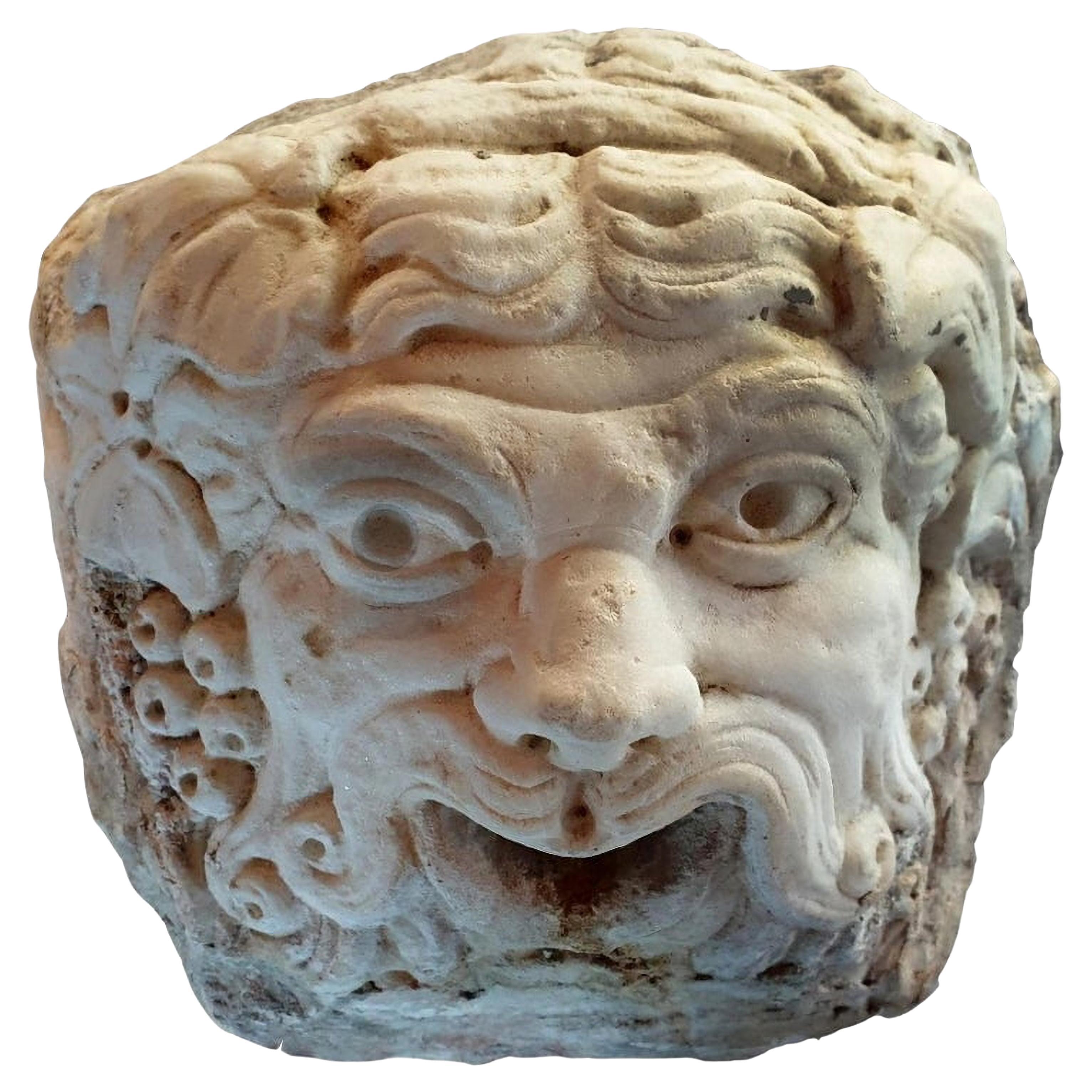Items Similar to Important Unique Italian Sculpture ATENA LEMNIA IN WHITE CARRARA MARBLE 19th Cen
Want more images or videos?
Request additional images or videos from the seller
1 of 6
Important Unique Italian Sculpture ATENA LEMNIA IN WHITE CARRARA MARBLE 19th Cen
About the Item
Important Unique Italian Sculpture ATENA LEMNIA IN WHITE CARRARA MARBLE 19th Century
Italy
Head in white Carrara marble, sculpted by us by hand with the aid of the "stitch machine", copied from a plaster cast from the original in the Bologna museum.
Museum base 15x15x15 cm with steel pin
HEIGHT 28 cm
WIDTH 18 cm
DEPTH 22 cm
WEIGHT 28 kg
ARTIST / DESIGNER / ARCHITECT Phidias (Athens, around 490 BC – Athens, around 430 BC)
MUSEUM TYPE BASE INCLUDED 15x15x15 + steel pin cm
MATERIAL White Carrara marble
MUSEUM WHERE THE ORIGINAL Civic Archaeological Museum is EXHIBITED, Bologna
Perfect conditions
Athena Lemnia was a bronze statue, made by Phidias in the 5th century BC. C. and which was located in the Acropolis of Athens.
History
Athens had sent a large group of settlers to the island of Lemnos in 450 BC. C. Later, the colonists, in gratitude, sent Pericles money so that he could pay tribute to Athena. Pericles commissioned a statue which was therefore called Lemnia.
Description
There is a possible Roman copy of this missing statue, formed by the union of two marble fragments: a head from the Civic Archaeological Museum of Bologna and a body from the Staatliche Kunstsammlungen in Dresden.
The statue was somewhat larger than life; He had the spear in one hand and with the other he held his helmet, thus having his head uncovered. The synthesis of strength and elasticity in their clothes stood out. The pleats were straight and ribbed. The aegis appeared crossed and could be a precedent for the Athena represented on the western pediment of the Parthenon.
The three famous statues of Athena - Promachos, Lemnia, Parthenos - created by Phidias represent so many stages in his work. All three were located on the Athenian Acropolis and rivaled each other in splendor. Unfortunately, no original has survived and we can only appreciate its charms through the existing copies. Around the year 450, a bronze statue of Athena, 2 m high, which had been commissioned from Phidias by the colonists, was consecrated on the Athenian Acropolis. who were leaving for the island of Lemnos. It was the Athena Lemnia, the exquisite beauty. This is how it was known in Antiquity, since Pliny says that it was "tam eximiae pulchritudinis ut formae cognomen acceperit." Luciano was enthusiastic about Lemnia's profile and that gives an idea of Luciano's good taste and how much he understood about art. Unlike the Promachos, the Lemnia represents Athena in a peaceful attitude, dressed with a peplum open on one side and cinched above the apoptygma, with the aegis extended over the chest and the head uncovered and inclined, fixing her gaze on the helmet that He holds in his right hand. The reconstruction of the original was a notable success by Furtwängler, who associated the best copy of the body preserved in Dresden with a copy of the head preserved in Bologna. The new typological scheme indicates that, towards the middle of the century, there is an evolution that also affects the style, since the Athena Lemnia has a more dynamic rhythm and a more advanced weighting than the Prómachos. Without a doubt, the greatest attraction of the work lies in the head, whose structure stands out admirably through the taenia that surrounds it. The spherical shape of the head and the severe beauty of the face acquire all their plastic strength in the profile, to which both the modeling of the features and the treatment of the hairstyle based on small, independent and finely articulated strands contribute. The novelties introduced by Phidias in this work, which also affect the treatment of the cloth, acquire enormous significance, because they constitute the starting point with respect to the new evolutionary stage reached in the Parthenos, hence the Athena Lemnia represents a milestone in the production fidíaca, in addition to being the summum in the ideal of classical beauty.
- Creator:Europa Antiques (Artist)
- Dimensions:Height: 11.03 in (28 cm)Width: 8.67 in (22 cm)Depth: 7.09 in (18 cm)
- Style:Romantic (Of the Period)
- Materials and Techniques:
- Place of Origin:
- Period:
- Date of Manufacture:19th Century
- Condition:Wear consistent with age and use. Very good condition Unique piece.
- Seller Location:Madrid, ES
- Reference Number:1stDibs: LU5779236005272
About the Seller
4.9
Platinum Seller
These expertly vetted sellers are 1stDibs' most experienced sellers and are rated highest by our customers.
Established in 2005
1stDibs seller since 2021
221 sales on 1stDibs
Typical response time: 1 hour
- ShippingRetrieving quote...Ships From: Madrid, Spain
- Return PolicyA return for this item may be initiated within 14 days of delivery.
More From This SellerView All
- Important Unique Italian Sculpture "ULISSE" HEAD CARRARA MARBLE 19th Cent.By Europa AntiquesLocated in Madrid, ES"Ulisse di Sperlonga" HEAD IN WHITE CARRARA MARBLE 19th Century good conditions Base in white Carrara marble with 15X15X15 steel pin included. HEIGHT 33 cm WIDTH 33 cm DEPTH 25 c...Category
Antique Late 19th Century Italian Romantic Figurative Sculptures
MaterialsCarrara Marble
- Important Unique Italian Sculpture MARCO AURELIO HEAD CARRARA MARBLE 19th Cent.By Europa AntiquesLocated in Madrid, ESMARCO AURELIO HEAD IN WHITE CARRARA MARBLE 19th Century Marcus Aurelius (Rome 121 - Vindobona 180 AD), head in white Carrara marble. Roman Emperor (161-180), follower of the philoso...Category
Antique Late 19th Century Italian Romantic Figurative Sculptures
MaterialsCarrara Marble
- Important Italian Sculpture "Diana Gabi" Carrara Marble 19th-20th CenturyBy Europa AntiquesLocated in Madrid, ESImportant Italian sculpture "Diana Gabi" Carrara marble 19th-20th century Very good condition.Category
Antique Late 19th Century Italian Baroque Busts
MaterialsMarble
- Italian Mask in White Carrara Marble 19th CenturyBy Europa AntiquesLocated in Madrid, ESITALIAN MASK IN WHITE carrara MARBLE 19th century Mask in white class P carrara marble HEIGHT 20cm WIDTH 20cm THICKNESS 10cm WEIGHT 12Kg MOUTH WIDTH 23 cm Good condition for the age.Category
Antique Early 19th Century Italian Baroque Figurative Sculptures
MaterialsCarrara Marble
- Important Italian Bust "Antonino Pio" End 19th Century Carrara MarbleBy Europa AntiquesLocated in Madrid, ESImportant Italian bust "Antonino Pio" fine 19th Century Marmo di Carrara Measure: H: 76cm perfect conditions Titus Aurelius Fulvo Boyonius Antoninus (Latin: T. Aurelius Fulvus Boion...Category
Antique Late 19th Century Italian Baroque Busts
MaterialsCarrara Marble
- Antique Italian White Carrara Marble Trougle, 19th CenturyBy Europa AntiquesLocated in Madrid, ESAntique Italian white Carrara marble trougle, 19th century. Measures : height 20 cm. width 34 cms. length 45 cm. internal depth of the...Category
Antique 19th Century Italian Baroque Figurative Sculptures
MaterialsCarrara Marble
You May Also Like
- Italian 19th Century Neoclassical White Carrara Marble SculptureLocated in West Palm Beach, FLA spectacular Italian 19th century neo-classical white carrara marble sculpture of Paulina Bonaparte signed by Carlo Fossi. Paulina was...Category
Antique 19th Century Italian Neoclassical Figurative Sculptures
MaterialsCarrara Marble
- Italian 19th Century Solid White Carrara Marble Signed SculptureLocated in West Palm Beach, FLA very impressive Italian 19th century solid white Carrara marble sculpture, signed S. Schroeder 1875. The statue is raised on a circular base depicting a draped artist, seated with ...Category
Antique 19th Century Italian Figurative Sculptures
MaterialsCarrara Marble
- Italian Neoclassical 19th Century White Carrara Marble Sculpture Guglielmo PugiBy Guglielmo PugiLocated in Miami, FLImportant 19th century sculpture carved on white Carrara marble. The female figure is dressed in a stunning Art Nouveau costume and rests on a pyramidal-shaped pedestal. Magnificent ...Category
Antique Late 19th Century Italian Art Nouveau Figurative Sculptures
MaterialsCarrara Marble
- Italian 19th Century White Carrara Marble StatueLocated in West Palm Beach, FLA charming and high quality Italian 19th century white Carrara marble statue of a young girl holding a scroll. The sta...Category
Antique 19th Century Italian Figurative Sculptures
MaterialsCarrara Marble
- Italian 19th Century White Carrara Marble StatueLocated in West Palm Beach, FLA stunning and extremely high quality Italian 19th century white Carrara marble statue. The wonderfully executed statu...Category
Antique 19th Century Italian Figurative Sculptures
MaterialsCarrara Marble
- Italian 19th Century White Carrara Marble StatueLocated in West Palm Beach, FLA stunning and most charming Italian 19th century white Carrara marble statue. The statue is raised by a wonderfully e...Category
Antique 19th Century Italian Figurative Sculptures
MaterialsMarble
Recently Viewed
View AllMore Ways To Browse
Antique Strength Machine
Acropolis Model
Classical Plaster Head Sculpture
Green Goddess
Grand Tour Youth
Cold Painted Dancer
Life Size Bronzer Statue
Houston Tx Furniture
The Lovers Bronze
Piano Sculture
Fire Dress
Eugene Brignola
Greek Goddess Nike
Glass Nativity
Cigar Statue
Ceramic Boots
Vietnamese Carved Furniture
Italian 1860





